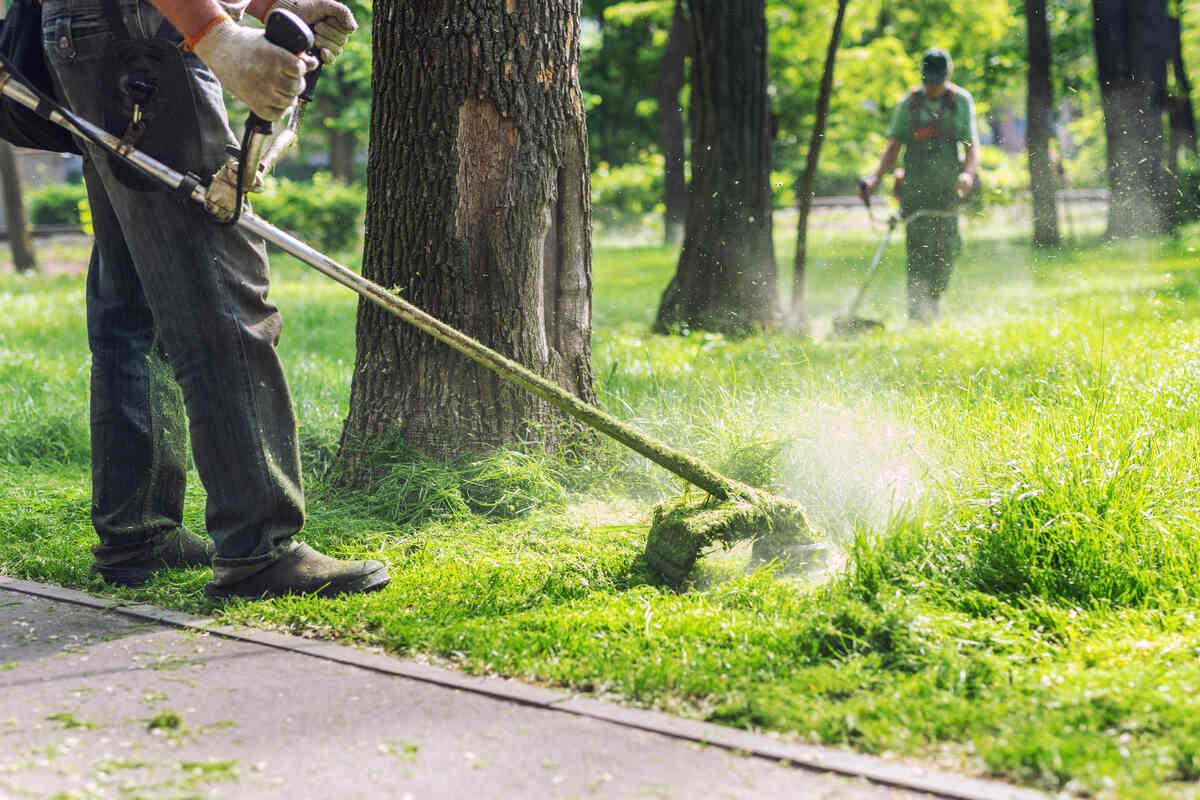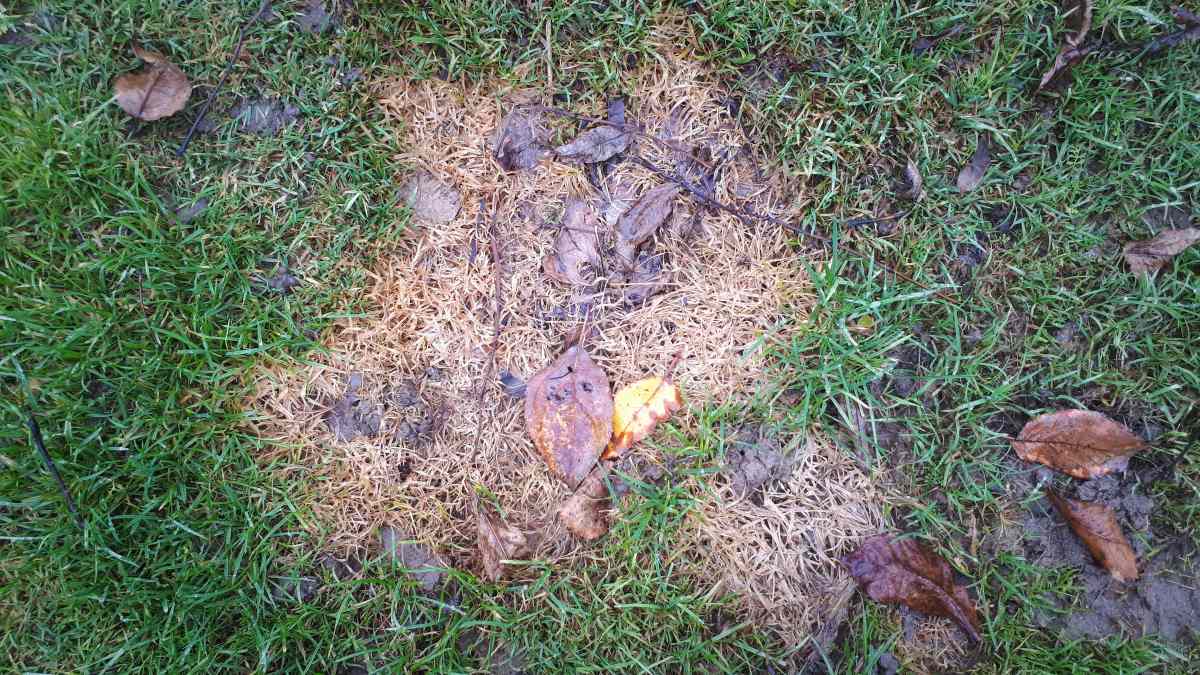
What is lawn mower blight? While it sounds like a fungal disease, it’s actually an injury to a tree caused by a lawnmower blade or string trimmer hitting its base.
When this happens, the impact strips away the bark, exposing the wood underneath to rot, pests, and diseases. In this article, we’ll cover all about lawn mower blight, including how to prevent it and ways to treat affected trees.
Why Lawn Mower Blight is a Problem

Much like our skin protects our body, trees rely on their bark to shield them from the outside world. But when you’re mowing tall grass or weeds around the base of a tree, it’s easy to accidentally strip away that essential protective layer.
The problem is that trees can’t simply grow new bark cells over a wound like we can heal a cut. Instead, they go through a process called compartmentalization, where they slowly build up callus tissue around the edges of the injury. This way, they create a barrier that helps stop infections from spreading.
However, the complete sealing of a lawn mower blight injury can take anywhere from 15 to 20 years. So, even while compartmentalizing, it remains vulnerable to termites, roaches, and fungi.
But, can even a small cut be harmful? Yes, but the impact depends on the extent of the damage. Travis Cleveland, a horticulture expert from the University of Illinois Urbana-Champaign, explains that if less than a quarter of the bark around the trunk is damaged, the tree will likely recover. However, it’ll still experience some stress, which could show up as wilting leaves or slower growth.
Now, if the lawn mower blight is more extensive, the tree will become girdled. Girdling happens when the bark is removed all the way around the trunk, cutting off the cambium layer. This is a thin layer of cells just under the bark that’s like the tree’s lifeline, responsible for moving water, sap, and nutrients from the roots up to the leaves.
When it gets severed, the tree starts to weaken. You’ll notice discolored leaves, a sparse canopy, or fungal growth, like anthracnose or cankers on the trunk. (Check out our article “Signs Your Tree is Dying” to learn more about what to look for.)
If left unaddressed, the tree’s condition will just keep getting worse. At that point, you may need to remove it to prevent it from falling over and causing damage. If it’s developed root rot, you’ll also need to dig up the roots to keep the disease from invading your yard.
Also read:
How to Treat Lawn Mower Blight
The truth is, there’s no direct treatment for lawn mower blight. You might think about using wound dressings or sealants, but many experts, including Cleveland, say these won’t help. In fact, they’ll probably get in the way of the tree’s compartmentalization process by trapping moisture.
Now, while you can’t reverse the damage, there are two main ways you can support the wound and encourage healing:
- Scribe the wound: Carefully cut away any ragged or dead bark around the injury to encourage the healing process.
- Prune properly: Remove dead or broken branches during the tree’s dormant season to minimize stress and help the tree focus on healing. You can find the best techniques for this in our guide, “How to Trim a Tree.”
For more information on dealing with tree wounds like lawn mower blight, read our article on “How to Treat Tree Wounds.” If the damage is too severe, see our guide on “How to Save a Dying Tree.”
How to Prevent Lawn Mower Blight

Since there’s not much you can do to fix the damage once lawn mower blight sets in, prevention is key. Here are a few tips:
- Spread 2 to 4 inches of mulch around your tree to retain moisture and protect it from mower damage.
- Mow the right way, keeping the mower at least 3 to 4 inches away from the trunk.
- Avoid using string trimmers around your trees; instead, use a hand-held shear for more precise trimming.
- Edge your tree’s base using vinyl, bricks, or cedar boards to create a weed-free area.
- Cage your young trees with wire fencing or plastic netting about 12 inches high, making sure to leave a 3-inch clear space around the trunk to prevent overgrowth.
Check our article on “How to Prevent Lawn Mower Blight” for a full breakdown of the best ways to keep your trees safe from mower and trimmer damage.
FAQ About Lawn Mower Blight
Which trees are most susceptible to lawn mower blight?
Species like poplar, willow, and birch are more at risk because their bark is softer and can get damaged easily by mowers or trimmers. Plus, trees that are already stressed from things like drought, poor soil, or disease have a tougher time bouncing back from lawn mower blight. Young trees of any kind are also more vulnerable since their bark hasn’t thickened enough to handle accidental bumps.
If you’re looking for plant species that are more resilient, check the following articles:
Is it safe to use fungicides on trees affected by lawn mower blight?
Applying fungicides to trees affected by lawn mower blight isn’t a good idea. While they can help manage some fungal infections that might pop up from the injury, they won’t actually heal the wound or restore the bark.
Plus, if the tree is already stressed from physical damage (especially if it’s young), using chemicals will make things worse. It’s always best to consult with a lawn care expert before trying any treatments.
How can I tell if my tree is recovering from lawn mower blight?
To spot signs of recovery in your tree, watch for:
- New leaves or buds in the spring or summer
- Callus tissue forming around the damaged areas
- A stable trunk with no new cracks or decay
- Fewer signs of stress like wilting or dropping leaves
- Leaves looking greener and more vibrant
When to Hire a Pro
Lawn mower blight is one of those things that’s completely avoidable if you know what you’re doing. An expert will take the heavy lifting off your hands and make sure your trees stay healthy and protected. If the damage is too severe, they’ll help with removal. But if there’s still hope, they’ll create a tailored care plan that includes mowing, pruning, mulching, and fertilizing to help your tree bounce back.
Don’t wait until it’s too late – reach out to a local lawn care pro today and get your trees the care they need.
Main Photo Credit: Kirill Gorlov / Adobe Stock Free / License
![7 Best Electric String Trimmers of 2025 [Reviews] man mowing grass with a trimmer with text overlay on it](https://www.lawnstarter.com/blog/wp-content/uploads/2021/01/Best-Electric-String-Trimmers.jpg)
![8 Best Cordless String Trimmers of 2025 [Reviews] person holding gasoline string trimmer with text overlay on it](https://www.lawnstarter.com/blog/wp-content/uploads/2021/01/Best-Cordless-String-Trimmers.jpg)

![7 Best Gas String Trimmers of 2025 [Reviews] handyman cutting grass with text overlay on it](https://www.lawnstarter.com/blog/wp-content/uploads/2021/01/Best-Gas-String-Trimmers.jpg)
